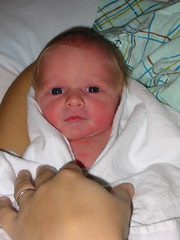Anyway, November 5th arrived and with it no labor and no pushing. I just showered, dressed and showed up at the hospital, where they took gave me a nightgown, took my vital signs and wheeled into the OR. Forty-five minutes later: baby!

It wasn't what I wanted, but it was fine. The operation went off without a hitch and my scar is nearly invisible. I endured a rough couple of days in the hospital since I had a bad reaction to the spinal anesthesia and my sleepy newborn lost enough weight that breastfeeding her involved taping formula to my chest for supplemental feedings. Still, a week later I was pushing her stroller around the block and she was nursing like a champ.
When I was pregnant with A, I knew from the start that I'd want a VBAC (vaginal birth after cesarean). Only my second born also favored the heads-up position. Fortunately an external version got her turned vertex and my midwives gave me the go-ahead to wait for labor to kick in.
A couple of days past my official due date, labor started. My first contraction hit at 9:40pm, just as I was going to bed. I stayed up all night, groaning, rocking on a ball and hugging a huge pile of pillows. At 9am, Josh and Trisha (my doula) accompanied me to the midwives' office, and since I was at 7cm, they waved me on to the hospital. You can read the whole birth story here, but suffice it to say I had enough time left to try every non-pharmaceutical labor enhancer and pain reducer before A finally showed her head--a full day later.

Natural childbirth was everything I'd hoped for and more. A whole lot more. I knew the pain would be intense, but I didn't know it would last. So. Long.
An epidural might have helped me since it might have provided me with enough relief that I could have rested a bit before pushing. But I didn't want an epidural because so many women have said yes to the epidural only to have their labors stall. Stalled labor is treated with Pitocin, and those Pitocin-driven contractions call for more pain relief. Intervention follows intervention and too often ends with a C-section. I'd had a C-section and I didn't want another. Particularly after I'd already done so much of the hard, physical work of labor.
What I'd wished for then was just a little relief--something to help me get through that awful period of transition. Something like the nitrous oxide that got my sister through her labors nearly medication-free. Nitrous is a common pain relief medication for laboring mothers in England and Australia, but it is virtually unknown American birthing centers.
Dr. Mark Sloane, author of Birth Day,
